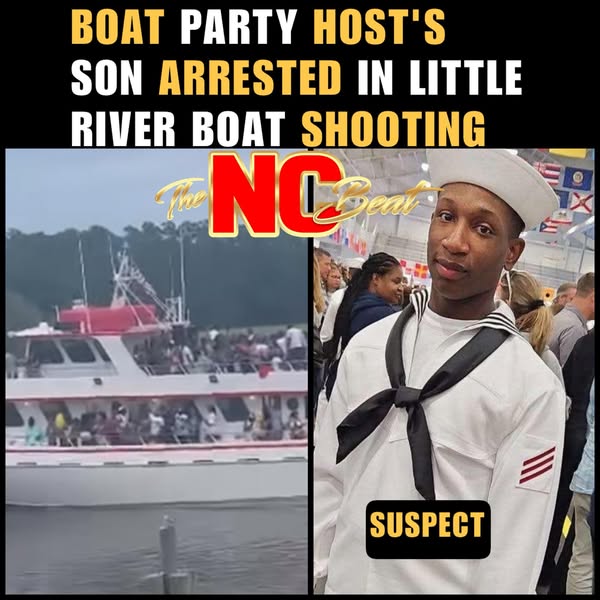
The arrest of 19-year-old Shawon Shamarion Williams has cast a sharp new light on the violent events that shattered the festive atmosphere of a Memorial Day weekend boat party in Little River, South Carolina. As of May 29, 2025, Williams is in custody in Lake County, Illinois, facing the gravity of multiple serious charges stemming from what authorities now classify as a mass shooting. According to law enforcement sources, Williams is accused of firing the gunshots that injured 10 individuals aboard a private boat gathering known as the “Rock Tha Boat Jackie-O” party—an event that was intended to be celebratory but ended in chaos and gunfire.
Williams, whose mother reportedly hosted the now-notorious gathering, is expected to be charged with multiple counts of attempted murder and possession of a weapon during the commission of a violent crime. Law enforcement officials have also indicated that more arrests may follow, signaling that the case is far from closed. The Horry County Police Department, the primary agency investigating the shooting, has urged the public to come forward with any information or materials that may assist in piecing together the sequence of events leading to the outbreak of violence.
This developing story, rooted in a community’s attempt to mark a national holiday with leisure and unity, has instead become emblematic of the increasingly complex dynamics of gun violence, youth involvement in high-risk situations, and the logistical difficulties law enforcement faces in managing large, semi-public events on waterborne venues. The case has also prompted broader discussions about liability, parental responsibility, and how recreational gatherings can escalate into scenes of tragedy when tensions, firearms, and alcohol collide.
As the investigation unfolds, questions abound: Who brought the firearms on board? What circumstances led to the eruption of violence? Was this a targeted confrontation or a spontaneous eruption of conflict? And how will the legal system respond to an incident that has deeply disturbed not only local residents but also a wider national audience following the case through social media and traditional news outlets?
At the center of these inquiries stands Shawon Shamarion Williams, a teenager whose arrest may be the first of several in a case that has already grown in complexity and scope.
The facts as they stand, although still emerging, paint a disturbing picture of the Memorial Day boat party that turned into a mass casualty incident. The “Rock Tha Boat Jackie-O” party took place on Sunday night, May 25, during the holiday weekend, and was attended by approximately 124 individuals. It was, by all initial accounts, a privately organized event, hosted aboard a docked charter boat in Little River—a scenic waterfront community known more for its picturesque views and peaceful coastal ambiance than for acts of violence.
But as the festivities progressed, what began as a social gathering evolved into something else entirely. An altercation—details of which have not yet been disclosed—broke out aboard the vessel. From that confrontation emerged gunfire, and within moments, panic and bloodshed followed. Ten individuals sustained gunshot wounds, and an eleventh was reportedly injured in a non-firearm-related incident. Those hurt were quickly transported to area hospitals, but the psychological trauma—among both attendees and the broader community—was already firmly cemented.
That this particular event gained such widespread notoriety is due in part to the viral nature of modern digital media. Video clips, photos, and first-hand accounts quickly circulated across social platforms, turning the boat party into a trending topic and the shooting into a national conversation. The fact that the party was hosted by Williams’ mother, and that her teenage son is now suspected of being the shooter, has only deepened the public’s interest in the case and widened the net of scrutiny.
By Thursday, May 29, Shawon Shamarion Williams had been located and taken into custody—not in South Carolina, but in Lake County, Illinois. Authorities have not disclosed what led them to that location, or whether Williams was attempting to flee, hide, or visit acquaintances. Regardless, his arrest outside the state underscores the urgency with which law enforcement agencies across state lines have treated the case. His extradition back to Horry County, South Carolina, is currently pending, but officials have confirmed that the charges awaiting him are severe and numerous.
The core charges—multiple counts of attempted murder and possession of a weapon during a violent crime—suggest a level of prosecutorial seriousness aimed at establishing both intent and severity. These are not incidental charges of negligence or lesser firearm offenses; they are allegations that speak to the deliberate use of deadly force in a crowded, enclosed environment.
The legal threshold for attempted murder in South Carolina is high, requiring prosecutors to demonstrate not just the presence of a firearm or the infliction of injury, but also a demonstrable intent to kill. The possession charge, while technically a separate offense, often functions in tandem with violent crime statutes to underscore the criminal use of a weapon, rather than simple illegal ownership.
Moreover, the fact that this shooting took place on a boat introduces additional layers of legal and procedural complexity. Maritime law may intersect with local jurisdiction, especially in cases involving commercial charters. Questions may arise regarding the responsibilities of the boat’s operators, safety protocols in place at the time of the party, and whether any violations occurred in the permitting or execution of the event.
The optics of the event have been particularly powerful. The imagery of a holiday celebration, particularly one organized by a mother and featuring attendees from multiple age groups, culminating in gun violence, has struck a deep chord. It challenges assumptions about where and how violence can erupt, and who may be held accountable when it does. The presence of a minor—albeit a 19-year-old legal adult—as the alleged shooter also redirects attention to the broader social issues of youth violence, gun accessibility, and familial oversight.
In many ways, the Little River boat party shooting joins a troubling list of public or semi-public celebrations disrupted by gunfire in the United States. From nightclub shootings to incidents at parades and house parties, a growing pattern is discernible: places of joy, leisure, or community gathering are increasingly becoming backdrops for deadly confrontations. These are not merely isolated criminal acts; they are reflections of deeper societal rifts, perhaps exacerbated by the proliferation of firearms, unresolved interpersonal conflicts, or broader cultural currents.
What remains unclear in this particular case is the motive behind the shooting. Law enforcement agencies have not yet released detailed findings about what triggered the altercation aboard the boat, who else may have been involved, or whether any of the injured were known to Williams. The lack of public information has led to speculation, but officials have remained tight-lipped, citing the active and ongoing nature of the investigation.
What is certain, however, is that the Horry County Police Department is not finished with its inquiries. Officials have indicated that more arrests may be forthcoming, implying that others may have played a role—whether as accomplices, co-conspirators, or negligent facilitators. This could include individuals who brought unauthorized firearms on board, failed to secure the perimeter of the event, or encouraged the altercation that led to gunfire.
The department’s public call for information—shared through official communication channels including phone and email—underscores both the seriousness of the probe and the investigative challenges it faces. With over a hundred attendees on board, and many likely in shock or fearful of legal repercussions themselves, obtaining reliable witness statements will be essential but potentially difficult. Digital evidence, such as smartphone videos, texts, or social media posts, may prove vital in reconstructing the timeline and assigning responsibility.
The psychological toll of the shooting has also been profound. For those injured, physical recovery may be just the beginning. Survivors of mass shootings frequently report long-term trauma, including post-traumatic stress disorder (PTSD), anxiety, and depression. The fact that this occurred in a confined space—on a boat—may exacerbate the sense of vulnerability and fear experienced by attendees.
Furthermore, the reputational damage to the Little River community cannot be overstated. Known for its quiet charm and welcoming demeanor, the town now finds itself associated with a violent crime that drew national attention. Local leaders may be faced with the dual task of restoring public confidence while also reassessing public safety protocols for events held in the area.
The arrest of Shawon Shamarion Williams may mark a turning point in the investigation, but it is far from its conclusion. Legal proceedings, public discourse, and the emotional aftermath will unfold over the coming weeks and months. Whether Williams is ultimately found guilty or not, his case will be scrutinized not only for its immediate facts but also for what it represents: a convergence of youth, violence, festivity, and tragedy in a time when such collisions seem increasingly commonplace.
In the end, the “Rock Tha Boat Jackie-O” party may serve as a cautionary tale—one that highlights the fragile boundary between celebration and catastrophe, and the responsibilities borne by those who organize, attend, and secure such events. As Horry County braces for the legal and emotional reckonings still to come, the name Shawon Shamarion Williams will remain etched in the collective memory of a community grappling with the aftershocks of violence, and a nation once again forced to confront its unresolved tensions around guns, youth, and public safety.
Williams now awaits extradition proceedings, and once returned to South Carolina, will face the full weight of the judicial system. Until then, the community watches and waits—searching for answers, reckoning with loss, and hoping for justice.
